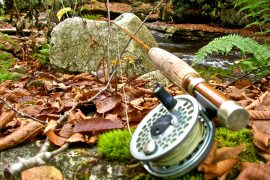[openquote]Their land swarmed with frogs, even in the chambers of their kings.[closequote]
– Psalm 105:30
The Unsung Heroes
[pullquote position=”right”]Amphibians are among the unsung heroes of their ecosystems.[/pullquote] Frogs, toads, and salamanders do a lot of heavy lifting in their habitats – smack dab in the middle of the food chain, they eat a lot of bugs and provide food for a lot of larger critters. Unfortunately, the Good Book isn’t too kind to them. Many folks associate the word “frog” with “plague” thanks to the bad press they get in Exodus, and Revelation likens them to evil spirits. Of course, even more folks associate “toad” with “wart” and you can’t blame the Bible for that. The bad news for amphibians goes beyond bad public relations, though. Their populations are declining at such alarming rates that it would take a miracle of Old Testament proportions to scrounge together a decent plague anywhere.
You probably remember the media attention given to three-legged Northern leopard frogs in Minnesota about 20 years ago. Although the attention faded, the frog deformities have increased. After decades of research, scientists have identified several potential contributing factors, from habitat loss to parasites to pesticide runoff to increased UV radiation levels to fungal infections, but no clear idea if the deformities really have a root cause. More than likely it is cocktail of all these (mostly) manmade causes – a little of this, a pinch of that, and it all trickles down to these little tadpoles who swim around and collect it all in their developing tissue. Research shows that very few of them grow up to be deformed adults; most of them die before getting to that stage.
But having a few extra legs isn’t even the worst thing happening to our amphibians, it’s just the one most of us have heard about. Many of them are just flat out disappearing from their habitats. Worldwide amphibian populations are declining by a whopping 3.7 percent per year on average, and have been for quite a while. This decline is disturbingly similar to the songbird decline discussed in the last Your Work Outside column. If this trend keeps up, in 30 years we definitely won’t have to worry about plagues of frogs because they’ll all be extinct. Of course, that percentage is just an average. Some species are declining faster than others. It is not surprising that species already classified as “endangered,” “vulnerable” or “near threatened” on the IUCN Red List of Threatened Species are declining the fastest, with an average decline of 11.6 percent each year. My personal favorite amphibian (everyone should have one) is the green salamander, Aneides aeneus, that calls Appalachian cliffs from central Alabama to southern Pennsylvania home. Green salamanders are listed as “near threatened” – they may not be around in a decade. But even species listed as “least concern” on the Red List, like most cricket frogs or the American toad, are still declining at a rate of 2.7 percent per year. They are all disappearing; some are just going more quickly.
Researchers believe that these declines are pretty much caused by the same factors that are deforming Minnesota’s leopard frogs, the cocktail of disasters, with one added factor. Much like the mysterious White Nose Syndrome that is wiping out bats in the US, there is a mystery fungus hammering on amphibians as well. Much like WNS, not a whole lot is known about the chytrid fungus Batrachochytrium dendrobatidis, only that it is found in many declining amphibians populations worldwide. Researchers are not certain if it is a newly evolved pathogen or one that has always been around but is only now devastating amphibians because they are already stressed by all those other damaging factors. Either way, it ain’t good. And, much like WNS, we just don’t know how to treat affected wild populations.
So, what can you do?
Your Work Outside columns always try to give you some kind of practical action to take to make a difference, and disappearing frogs is a hard one to tackle. For a start, you can certainly dig a pond in your yard or otherwise improve wetland habitat in your area. But a new study from the University of Georgia points to a contributing factor to the decline of at least one amphibian that you can actually do something about quickly and cheaply! If you live in the Eastern United States then the forest near you is probably infested with a seriously invasive, non-native grass called Japanese stiltgrass aka Nepalese browntop aka Microstegium vimineum. In the next column, I’m going to go into a little detail about invasive plants and all the bad stuff they do to local ecosystems. For now you just need to know that stiltgrass infests creek corridors, riverbanks, and hiking trails aggressively enough to crowd out the indigenous native plants, which make things rough on wildlife habitat. Although apparently the stuff is really good for wolf spiders.
Now, I am not anti-spider by any means. I love seeing the huge black-and-yellow orb weavers in our garden, and whenever a spider crawls across the kitchen floor we pick it up and gently place it outside, as opposed to screaming and vigorously assaulting it with a magazine. However, you can have too much of a good thing. The researchers at UGA maintain that wolf spider populations are booming in this stiltgrass habitat to the point where the spiders are eating an inordinate number of baby toads. Toads, particularly the American toad (Anaxyrus americanus) which frequent the same forested areas that stiltgrass now dominates, are being gobbled up by this artificial inflation of wolf spiders – and who knows what other species are being affected since the researchers just focused on toads. Therefore, knocking back the stiltgrass a little could at least help out the toads a bit, while the spiders may theoretically return to a little more natural population size. Fortunately, in some ways stiltgrass is easy to address – if you are patient and persistent. All you need to do is go hand pull it in late summer, right before it goes to seed. No herbicide needed, and it is really easy to pull. So if it’s so easy to get rid of, why is it a problem? Mainly because each plant produces thousands of seeds each year and has a seven-year seed bank–if you hand pull an acre this year on a nice summer day you will need to hand pull the same acre each summer for the next six years in a row before you really see any difference. If you miss a year, you start over. That kind of dedication is pretty rare, therefore stiltgrass is everywhere.
But everywhere isn’t your responsibility. Your backyard is your responsibility, your neighborhood park, the creek down the road. You probably aren’t going to stop all pesticide use in your state in one day, or cure chytrid fungus, but you can spend one sunny day each year pulling a few weeds by a creek with your family. That won’t bring the worldwide decline in amphibian populations to a screeching halt, or even make a dent, but you might help a handful of toads in your neighborhood survive to grow up and have babies of their own, maybe more than if you don’t pull those weeds. It sure couldn’t hurt, and it’s pretty unlikely you’ll be releasing a plague of toads on the neighborhood. That would be a real miracle–but you have to start somewhere.




